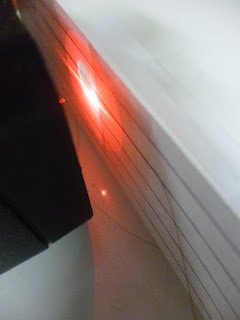For this experiment, the concept of interference would be applied to measure a human hair with the helium-neon laser.
The concept of inference of light is that when the interference is constructive, the intensity is maximum, hence showing the bright region. On the other hand, when the interference is destructive, the intensity is minimum, hence showing the dark region. In this experiment, the equation, ym=Rmλ/d,would be applied to calculate the thickness of the hair. For this equation, the only known variable was the wavelength of the helium-neon laser, which was known as 632.8 (nm). Therefore, in this experiment, the distance between the light source, as well as where the hair was put had to be measured. Besides it, the position of the fringes had also be measured. This distance would be measured from one bright region to the adjacent bright region. IT could also be measured from the center of the interference pattern to the mth bright region. After obtaining this distance, it had to be divided by the numbers of bright regions so that the distance ym could then be obtained. In order to get the interference fringes, the laser had to point through the hair directly, and perpendicularly to the white board. After obtaining those measurements mentioned above, the thickness of the hair would then be measured by using a micrometer to see if the result would agree to each other, and the better method had to be chosen if the result did not quite agree to each other.
Laser point to the hair
the laser would point through the hole where the hair was put
This picture showed clearly that laser point directly and perpendicularly through the hole
Use the marker to mark the distance between the fringes, then measure it afterwards
Use Micrometer to measure the thickness of the hair
Data:
Wavelength
|
632.8
(nm)
|
L
|
109±(cm)
|
y
|
0.8±0.05(cm)
|
d
|
90±3 (µm)
|
Calculation:
λ=d*y/L
-->d=λ*L/y
-->d=(6.328×10-7(cm)×109(cm))/0.8(cm)
= 8.62×10-3(cm) = 86.2(µm)
Uncertainty:
√((∂ d/∂ L*∂ L)2+(∂ d/∂ y*∂ y )2)= √((λ/y*∂L)2+(-λL/(y^2)* ∂y)2)
√((632.8×10-7/ 0.8*0.5)2+(-632.8×10-7×109/0.82*0.4 )2)=4.31×10-4(cm)=4.3(µm)
Result:
d(laser)
|
±4.3 (µm)
|
90.5(µm)
|
86.2(µm)
|
81.9(µm)
|
|
d(micrometer)
|
89.7(µm)~90.3(µm)
|
|
Conclusion:
From the thickness of hair calculated by using the helium-neon laser, the result was 86.2 (µm). However, the result measured by the micrometer was
90±3 (µm) , With the uncertainty plus or minus 4.3 (µm), the result obtained by using the helium-neon laser become the range from 81.9 (µm) ~ 90.5 (µm). Therefore, the range was within the number obtained by using the micrometer. It showed us that by using the helium-neon laser and by applying the concept of interference of light, the thickness of the hair could be measured. Since the thickness of the hair was really small, and since the distance between the whiteboard and the slit was large compared to the distance between two bright fringes. Therefore, the equation ym=Rmλ/d could be applied, and the experiment also proved that this equation worked for measuring the thickness of the hair. Since this equation could be used in this experiment, and based on what the concept of the two-source interference of light, it showed us that light waves constructed at where the brightest points were, and destructed at where the darkest points were. Therefore, with the applying of interference of light concept, the result of the hair's thickness could be more accurate compared to the hair's thickness measured by the micrometer. However, if the experiment had to be done with applying the interference of light theory, the high intensity source, such as the laser had to be fetched easily. It is the disadvantage of the interference of light. However, on the other hand, if the micrometer was not provided, the concept of interference could be applied to measure the target object.






No comments:
Post a Comment